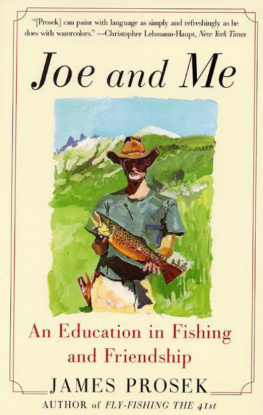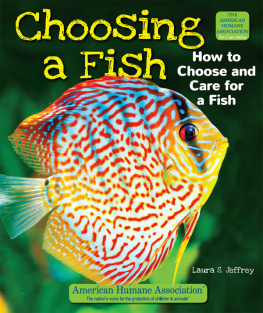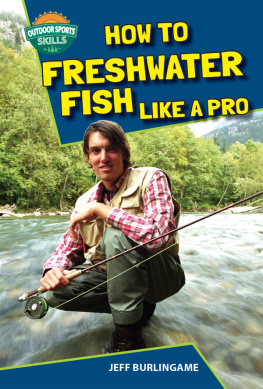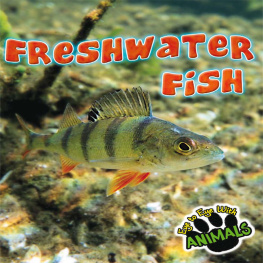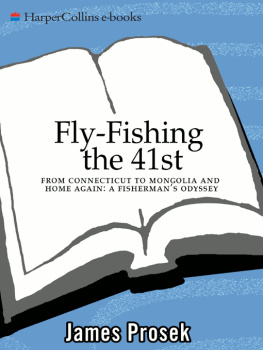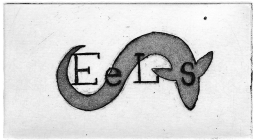EELS . Copyright 2010 by James Prosek.
All rights reserved under International and Pan-American Copyright Conventions. By payment of the required fees, you have been granted the non-exclusive, non-transferable right to access and read the text of this e-book on-screen. No part of this text may be reproduced, transmitted, down-loaded, decompiled, reverse engineered, or stored in or introduced into any information storage and retrieval system, in any form or by any means, whether electronic or mechanical, now known or hereinafter invented, without the express written permission of HarperCollins e-books.
FIRST EDITION
Library of Congress Cataloging-in-Publication Data has been applied for.
ISBN 978-0-06-056611-1
10 11 12 13 14 ov/ RRD 10 9 8 7 6 5 4 3 2 1
EPub Edition AUGUST 2010 ISBN: 978-0-062-00881-7
Thousands passed the lighthouse that night, on the first lap of a far sea journeyall the silver eels, in fact, that the marsh contained. And as they passed through the surf and out to sea, so also they passed from human sight and almost from human knowledge.
R ACHEL C ARSON , 1941
Contents
A TRANSITION
In Mind to Eels

My wall of eel spears
T he eel is not an easy fish to like. It doesnt have the beauty of the trout or the colors of the sunfish. As kids, my friends and I caught eels by accident while casting for something else. Unable to grip their muscular, slimy bodies, we stunned them with a smack on the riverbank, then pinned them down with our heels just long enough to remove our hooks from their mouths. We threw them back in the water and watched, astonished, as they swam away.
Eels pulsed through my New England upbringing, there and then not there. Something about them made me curious even if I could not name it. My friend Joe Haines, an old game warden, used to cook them, big eels, trapped unwittingly as they tried to pass through the dam on the Saugatuck Reservoir on their fall migration to the sea. I asked Joe where the eels were going. The answer was always the samethe Sargasso Sea. But where was that? Far away. There was something mysterious in the idea that this fish, which swam in the waters where I waded barefoot in summer, was born thousands of miles away in the blue ocean.
My mother told me that her earliest memory as a girl growing up in Trieste, Italy, was of seeing eels heads chopped off by the fishmonger in the markets. Why did the eel and the snake, these minimal creatures, make such lasting impressions on our psyches? I stumbled on eels in the photography of Cartier-Bresson, in the paintings of Manet and Leonardo (with orange slices in the Last Supper), in the novels of Gnter Grass and Graham Swift. When I started fishing for striped bass we used them for bait, casting them off the beach on chill fall nights where surf spray mingled with stars, on Cuttyhunk Island and Marthas Vineyard.
At the time I had thought these strange travelers were unique to North America and Europe (the European eel also spawns in the Sargasso Sea). I had not known that there were other species of eels around the world that made migrations from the rivers of other continents to spawn in other oceans. A friend whod lived in New Zealand told me that there were giant freshwater eels in the islands rivers and that these eels were important to the culture of the indigenous Maorisymbols of the movement of water, synonyms of the phallus, sacred guardians, and monster seducers. He said the Maori kept eels in ponds and fed them by hand, that these fish were known to live for hundreds of years and grow over six feet in length. A fish that once had been an accident on my hook had begun to wedge itself persistently in the crevices of my imaginationa thread that tied the ocean and the rivers together and made me feel like the world was held by one interconnected system of beauty, magic, and mystery.
One day I stood at the edge of a lake in Tuscany with my friend and editor, Larry Ashmead, now retired from HarperCollins. We looked out across the surface of the water below a Tuscan hill town, and he asked me what the stakes in the mud were marking (the town was Cortona, the lake Trasimeno). I told him that they were traps for eels, fish that were born thousands of miles away in a warm eddy in the ocean called the Sargasso Sea. He said he didnt believe me. When I got home there was a package with a photocopy of an essay by Rachel Carson on eels, and a note from Larry that said he thought the story of this fish might make a good book.
Eels
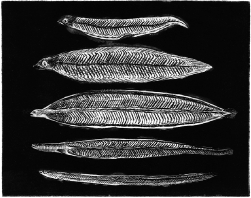
Metamorphosis of eel larva to glass eel
C onjecture about what an eel is exactly, or where its place is in the tree of life, has racked the brains of more than a few naturalists. Its limbless elongated body led some to believe it was related to the snake. The Greek naturalist and poet Oppian wrote in the second century A.D. : Nothing more is known, than what people repeat about the loves of Roman eels and snakes. Some say that they pair, that, full of eagerness, drunk with desire, the Roman eel comes out of the sea to go and meet her mate. As late as 1833 Jerome V. C. Smith wrote in his Natural History of the Fishes of Massachusetts: On the whole, we view the eel in the light of a water-serpent, being the connecting link between purely aquatic and amphibious reptiles. The eel, however, is a fish, though it is a fish like no other.
The freshwater eel, of the genus Anguilla, evolved more than fifty million years ago, giving rise to fifteen separate species. Most migratory fish, such as salmon and shad, are anadromous, spawning in freshwater and living their adult lives in salt water. The freshwater eel is one of the few fishes that does the opposite, spawning in the sea and spending its adulthood in lakes, rivers, and estuariesa life history known as catadromy (in Greek


